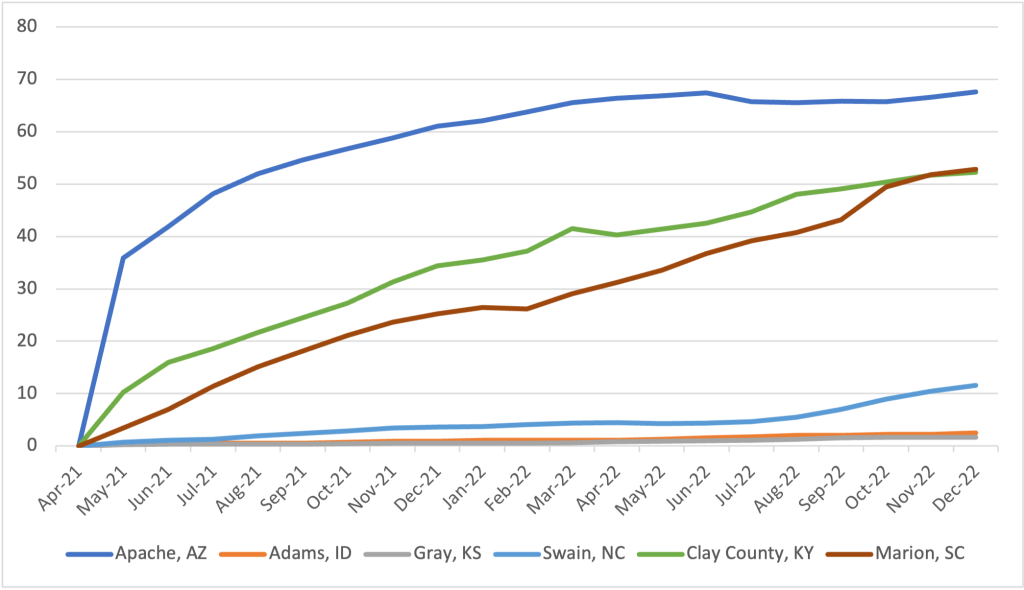- There is a lot we can learn from the successes and challenges of broadband subsidy programs like the Affordable Connectivity Program (ACP) to improve future programs in the US and other countries.
- ACP adoption rates were poor in rural counties with predominantly agricultural or industrial workforces and those with older populations. Economically mixed neighborhoods had greatest adoption rates.
- The success of the ACP (or any means-tested welfare program) needs local resources and greater policy attention to poverty. Greater attention is required in implementing these programs, specifically in awareness building, marketing, and publicity
The Affordable Connectivity Program (ACP) is one of several US federal and state government programs that seek to bridge the so-called “digital divide” through targeted consumer subsidies and support for infrastructure rollout.
Its predecessor, the Emergency Broadband (EBB) Program, was introduced as part of the Consolidated Appropriations Act of 2021. When the EBB transitioned to the ACP in December 2021, subsidies per household were set at USD 30 per month (USD 75 for eligible consumers in tribal lands) for broadband and a one-time USD 100 subsidy for a laptop, desktop, or tablet computer.
Though these subsidy programs aim to improve vital broadband and telecommunications access to low-income households, their uptake has varied across US states and counties. This fits the pattern of low participation rates in other means-tested broadband subsidy programs such as Lifeline and Linkup. The causes are many: lack of awareness, poor integration with other social welfare programs, and onerous documentation.
Although the ACP was terminated in June 2024 after the US Congress failed to renew funding, there is a lot we can learn from its successes and challenges to improve future means-tested broadband subsidy programs in the US and other countries. To this end, the Information Policy Research Group at Penn State University is working on understanding the factors associated with ACP uptake rates at the county level.
Adoption Rates Vary According to Economic and Demographic Factors
Unlike previous studies, we are not focusing on the cross-sectional comparisons of ACP penetration. Instead, we aim to explain the adoption rates at the county level, using panel data on monthly ACP subscriber additions in all 3,000-odd US counties over the time the ACP was implemented.
A selection of county cases in Figure 1 illustrates why we focus on the adoption rate. Adoption rates varied dramatically across counties, with some achieving a fast initial take-off, others having slow but steady growth, and still others never taking off. If counties where the rate of adoption is likely to lag can be identified ahead of time, marketing and promotional efforts may be concentrated there.
Our statistical model assumes that new monthly ACP signups will be proportional to the number of eligible non-subscribers in the market. As the program continues to sign up subscribers, this pool will continue to shrink, leaving fewer “unconverted” eligible households to sign up. Eventually, new subscriber additions will level off at some penetration level, as in Apache County, Arizona.

When considering economic and demographic factors, our results showed that counties with older populations had lower ACP uptake rates. So did rural counties and those with predominantly agricultural or industrial workforces compared to counties with service-oriented economies. We also observed that once the program caught on, it tended to be sustained month after month. This was the case in Clay County, Kentucky, and Marion County, South Carolina.
County Poverty Rates Negatively Correlated With ACP Adoption
This was perhaps the most curious result, given that the ACP targeted low-income households. However, county median income also negatively predicted the ACP uptake rate. Wealthier counties (measured by median income) did less well than less wealthy counties.
We resolve this apparent contradiction by arguing that the success of the ACP (or any means-tested welfare program) needs local resources and greater policy attention to poverty. Wealthier countries may have more resources, but they may not attribute much salience to poverty alleviation unless there are many households in need. In other words, economically mixed neighborhoods do best.
To test this proposition, some of our models included the GINI coefficient (an income inequality metric), a strong positive predictor of ACT uptake.
The biggest takeaway from our study so far is that greater attention is required in implementing these programs, specifically in awareness building, marketing, and publicity. Learning from the implementation strategies of counties with the greatest adoption rates will lead to savings in marketing and promotion and better interventions in the future.
This post is based on a research project conducted by the Information Policy Research Group at the Pennsylvania State University. Project members include Dong Wook Jeong, doctoral student, Penn State; Ryan Wang, assistant professor, Louisiana State; Krishna Jayakar, professor, Penn State; Christopher Ali, professor and Pioneer’s Chair, Penn State; Sascha Meinrath, professor and Palmer Chair, Penn State; and Sydney Forde, doctoral student, Penn State. Preliminary results were presented at the TPRC 52 Conference in September 2024.
Krishna Jayakar is a Professor, head of the Department of Telecommunications, and Co-Director of the Institute for Information Policy at Pennsylvania State University.
The views expressed by the authors of this blog are their own and do not necessarily reflect the views of the Internet Society.
Photo by Tabitha Hawk VIA Wikimedia Commons


